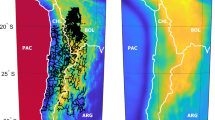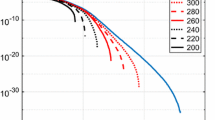Abstract
Spectral methods have been a standard tool in physical geodesy applications over the past decade. Typically, they have been used for the efficient evaluation of convolution integrals, utilizing homogeneous, noise-free gridded data. This paper answers the following three questions:
-
(a)
Can data errors be propagated into the results?
-
(b)
Can heterogeneous data be used?
-
(c)
Is error propagation possible with heterogeneous data?
The answer to the above questions is yes and is illustrated for the case of two input data sets and one output.
Firstly, a solution is obtained in the frequency domain using the theory of a two-input, single-output system. The assumption here is that both the input signals and their errors are stochastic variables with known PSDs. The solution depends on the ratios of the error PSD and the signal PSD, i.e., the noise-to-signal ratios of the two inputs. It is shown that, when the two inputs are partially correlated, this solution is equivalent to stepwise collocation.
Secondly, a solution is derived in the frequency domain by a least-squares adjustment of the spectra of the input data. The assumption is that only the input errors are stochastic variables with known power spectral density functions (PSDs). It is shown that the solution depends on the ratio of the noise PSDs.
In both cases, there exists the non-trivial problem of estimating the input noise PSDs, given that we only have available the error variances of the data. An effective but non-rigorous way of overcoming this problem in practice is to approximate the noise PSDs by simple stationary models.
Similar content being viewed by others
References
Barzaghi, R., Fermi, A., Tarantola, S. and F. Sansò. 1993. Spectral techniques in inverse Stokes and overdetermined problems.Surveys in Geophysics, Vol. 14, No. 4–5.
Bendat, J.S. and A.G. Piersol. 1980.Engineering applications of correlation and spectral analysis, John Wiley and Sons, New York.
Bendat, J.S. and A.G. Piersol. 1986.Random data: Analysis and measurement procedures, Second edition, John Wiley and Sons, New York.
Bottoni, G.P. and R. Barzaghi. 1993. Fast collocation.Bulletin Géodésique, Vol. 67, No. 2, pp. 119–126.
Bracewell, R.N. 1986.The Fourier Transform and its Applications, Second edition, revised. McGraw-Hill, New-York.
Li, J. and M.G. Sideris. 1995. Marine gravity and geoid determination by optimal combination of satellite altimetry and shipborne gravimetry data. Paper presented at theXXI IUGG General Assembly, July 2–14, Boulder, Colorado. Also submitted to theJournal of Geodesy.
Li, Y.C. 1993. Optimized spectral geoid determination. UCGE Report No. 20050, Department of Geomatics Engineering, The University of Calgary, Calgary, Alberta.
Li, Y.C. and M.G. Sideris. 1994. Minimization and estimation of geoid undulation errors.Bulletin Géodésique, Vol. 68, pp. 201–219.
Moritz, H. 1980.Advanced physical geodesy. H. Wichmann Verlag, Karlsruhe, Germany.
Sansò, F. and G. Sona. 1995. The theory of optimal linear estimation for continuous fields of measurements.Manuscripta Geodaetica (in print).
Sansò, F. and M.G. Sideris. 1995. On the similarities and differences between systems theory and least-squares collocation in physical geodesy. Paper presented at theXXI IUGG General Assembly, July 2–14, Boulder, Colorado. Also submitted to theJournal of Geodesy.
Schwarz, K.P., Sideris, M.G. and R. Forsberg. 1990. The use of FFT techniques in physical geodesy,Geophysical Journal International, Vol. 100, pp. 485–514.
Sideris, M.G. 1987. On the application of spectral techniques to the gravimetric problem. InProc. of the XIX IUGG General Assembly, Tome II, Vancouver, B.C., August 9–22, pp. 428–442.
Wang, Y.M. 1993. On the optimal combination of geopotential coefficient model with terrestrial gravity data for FFT geoid computations.Manuscripta Geodaetica, Vol. 18, No. 6, pp. 406–416.
Wu, L. and M.G. Sideris. 1995. Using Multiple Input-Single Output System Relationships in Post Processing of Airborne Gravity Vector Data. InProc. of IAG Symposium G4: Airborne Gravity Field Determination, XXI IUGG General Assembly, July 2–14, Boulder, Colorado.
Author information
Authors and Affiliations
Rights and permissions
About this article
Cite this article
Sideris, M.G. On the use of heterogeneous noisy data in spectral gravity field modeling methods. Journal of Geodesy 70, 470–479 (1996). https://doi.org/10.1007/BF00863619
Received:
Accepted:
Issue Date:
DOI: https://doi.org/10.1007/BF00863619




